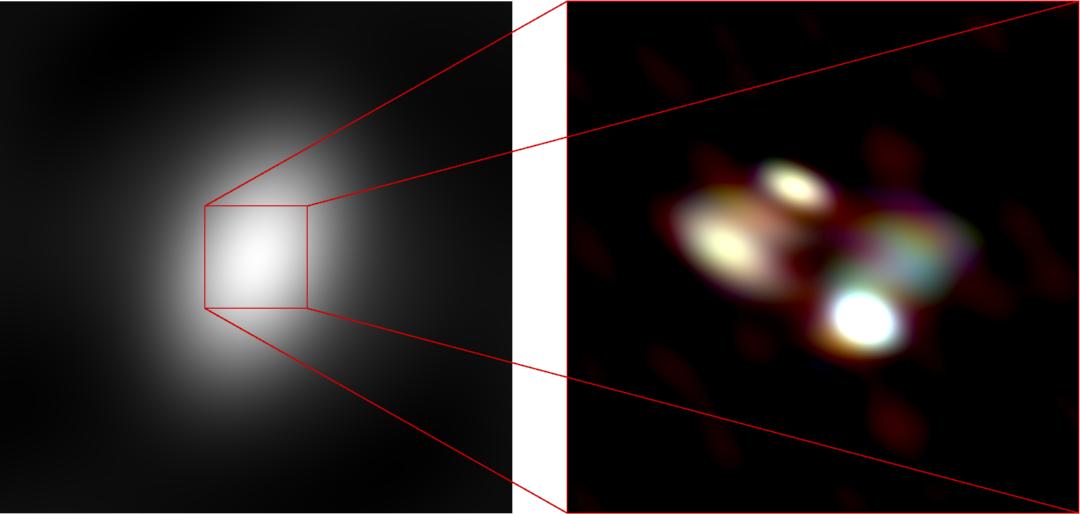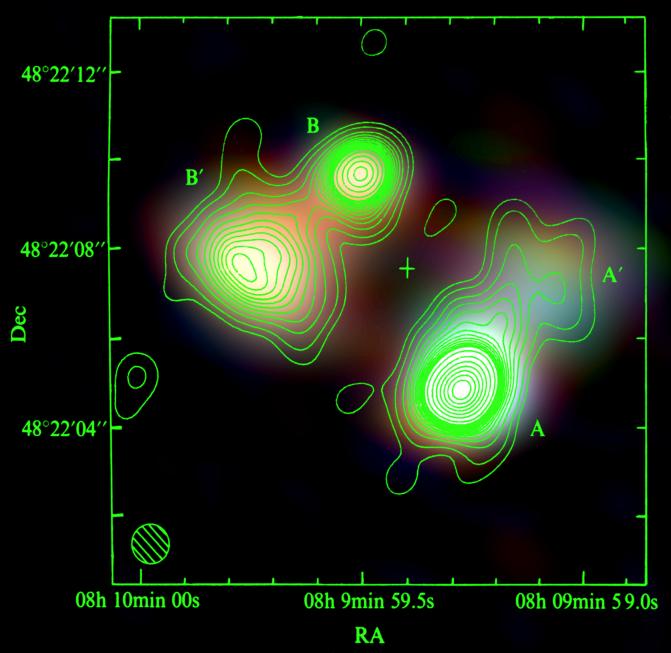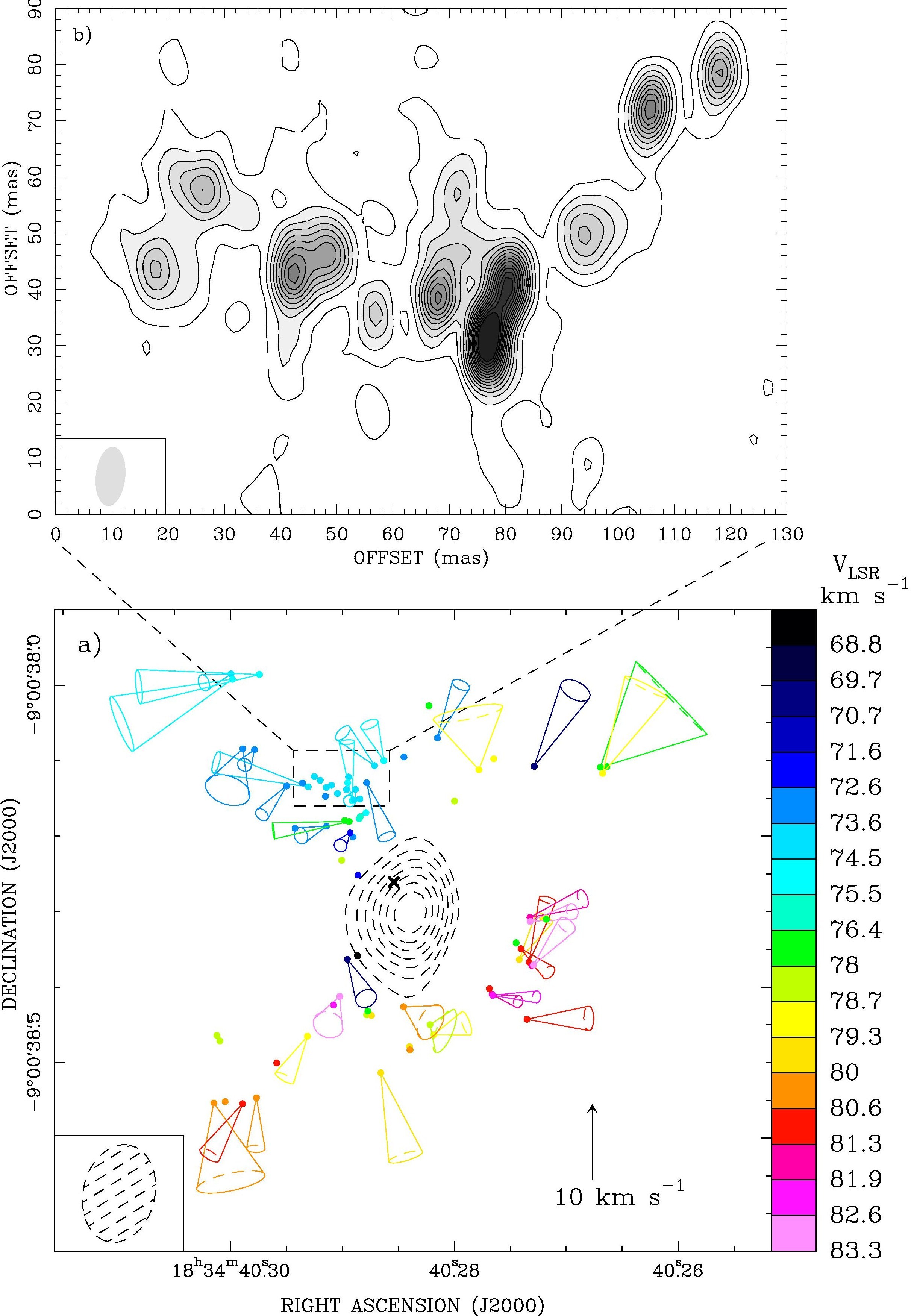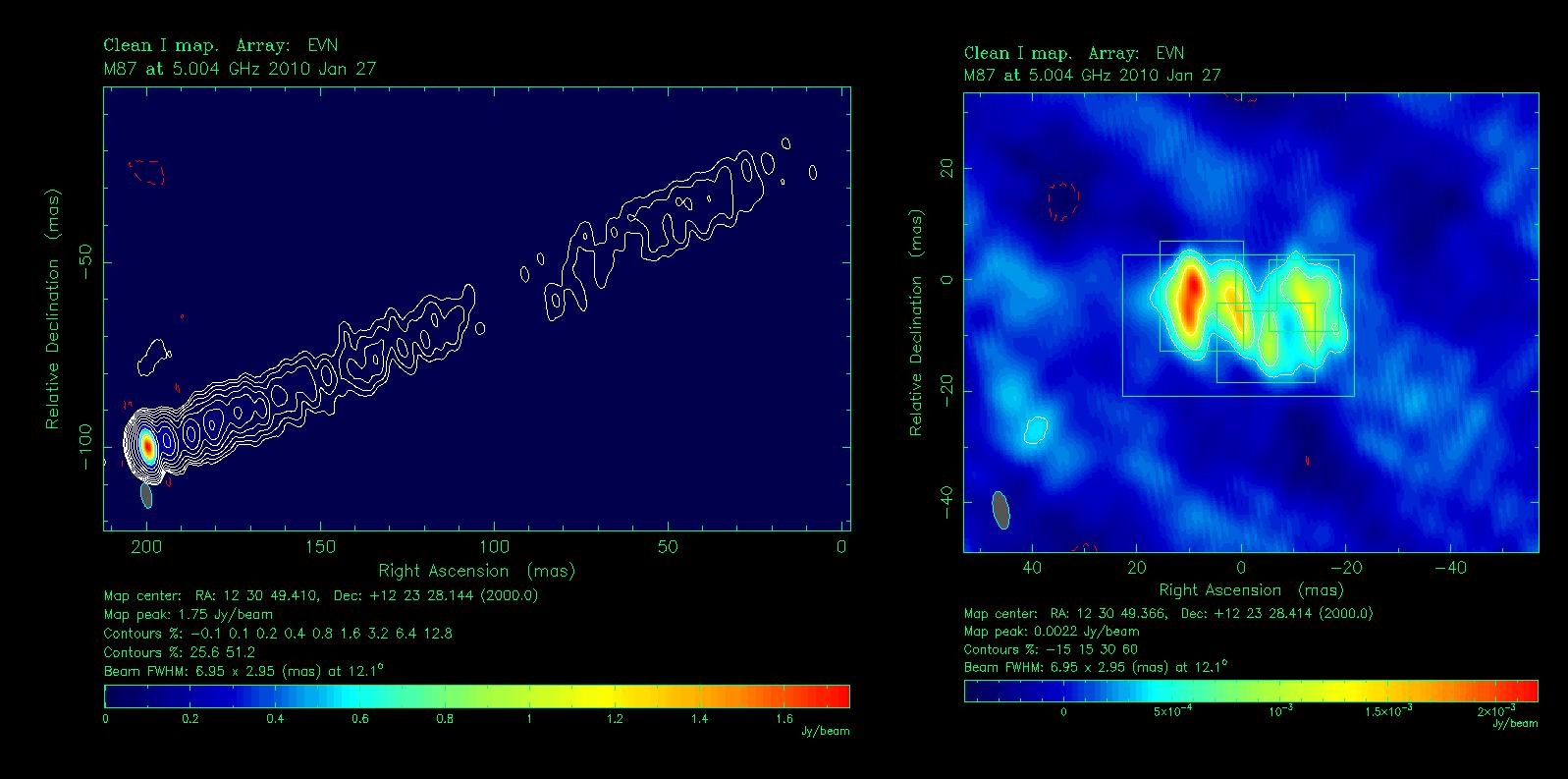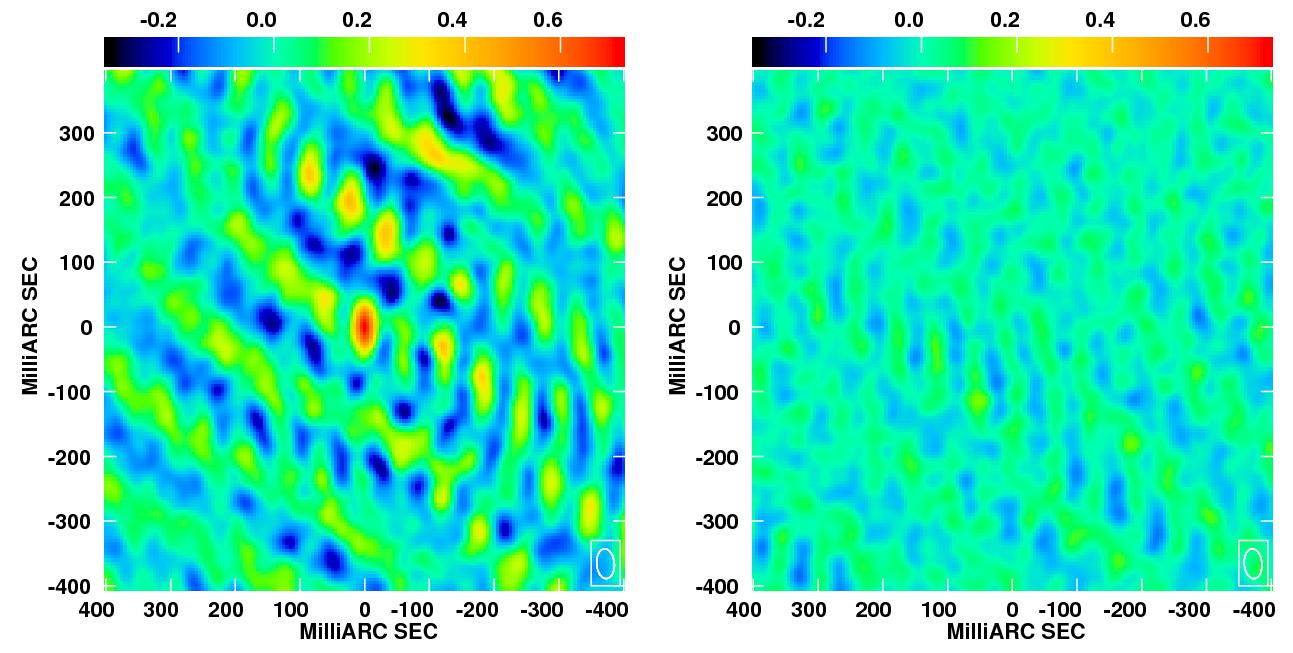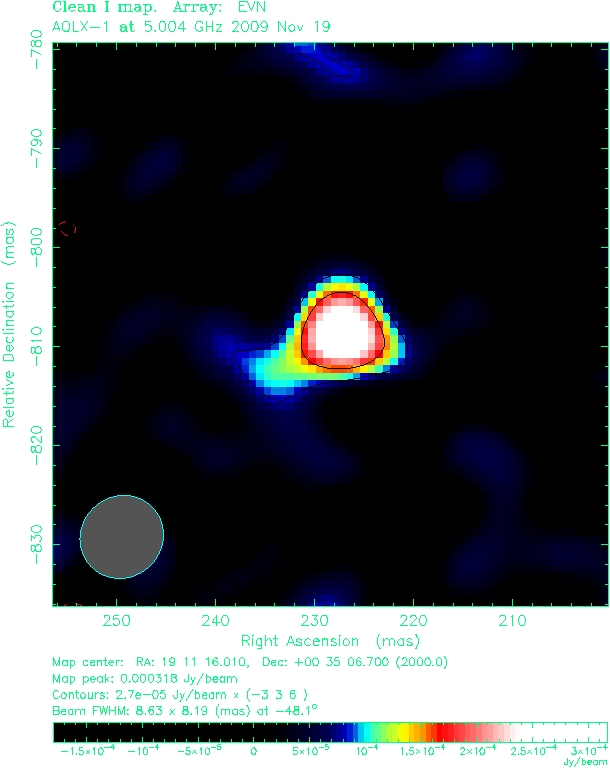|
|
European
VLBI Network Newsletter Number
26 May 2010 |
1. Message
from the EVN Chairman
Dear Reader,
As usual the EVN Newsletter updates information on recent EVN organizational
changes,
technological progress and the most important the scientific achievements.
On behalf of EVN CBD I'd like to give some details on later decisions taken
by EVN
Directors. As you know the volcano ash cloud disrupted air communication
and in fact made
impossible to organize regular CBD Meeting, this time planned to be at Torun.
As the
functioning of EVN should not be affected the CBD organized for the first
time (and I hope
the only one) the teleconference instead. The next CBD will be hosted by
the IAA at St.
Petersburg on beginning of October. The Russian Kvazar network was
incorporated into EVN
in November 2009 and since provides stream of good quality, valuable data.
Visiting our
partner there will help to improve and to expand our fruitful co-operation.
There are
changes in EVN PC, an new at large member was selected and appointed - Prof.
Nektarios
Vlahakis a specialist on theory of AGNs. The CBD made a decision to
simplify ToO
procedures, it should make it easier and quicker to get observing time. The
Board made
decision to cease activity within the GVWG (Global VLBI Working Group) and
bring an issue
to the close. This body which was created ~30 years ago lost its power and
significance
for the community.
All the EVN services function normally. We notice steady progress in Network
operation,
the technical development and scientific results.
Recent highlights in these areas are presented in the letter. I'd like to
draw you
attention specially to interesting results on gas kinematics in high mass
stars forming
areas derived on methanol maser sources and on first EVN results for
PSRJ2032+4127
processed at Bonn DiFX software correlator.
With great interest we read about progress at Yebes 40m telescope. The
installation of new
96 GHz receiver and VLBI fringes between Yebes, Onsala and Metsahovi show
growing
potential to perform high frequency observations within EVN.
These and many other worth reading news are presented in the letter.
The EC funded RadioNet program has been of great success for FP6 and it
continuous to be
so for FP7. A large support goes to EVN via Trans National Access
and Network Activities funds, some throughout Joint Reserach Activities.
Significant development of new technologies within the
program makes
us stronger in the global competition. Multi beam radio cameras, advanced
digital
technologies, mm and sub-mm arrays developments pave the way towards future
investments.
At the recent RadioNet Meeting on Sardinia the new Chairman (Prof. Franco
Mantovani) and
V-ce Chair (Prof. Rafael Bachiller) were appointed by the Board. I'd like
to congratulate
them and wish success with the completion of all tasks in this important
international
activity.
Being in Sardinia we had a chance to visit a site, where an impressive
investment work is
conducted. The 64m SRT is now being assembled and as we heard the telescope
will be able
to start basic operation in the next year.
Andrzej Kus, Chairman of the EVN Board of Directors.
|
64m Sardinia Radio Telescope |
2. Call
for EVN Proposals - Deadline June 1st 2010
ALL EVN,
GLOBAL, and e-VLBI PROPOSALS must now be submitted
with the
ONLINE
PROPOSAL SUBMISSION tool Northstar.
(This text is also
available on the web at http://www.ira.inaf.it/evn_doc/call.txt)
Observing proposals are
invited for the EVN, a VLBI network of radio telescopes spread throughout
The
observations may be conducted with disk recording (standard EVN) or in real-time
(e-VLBI).
The
EVN is open to all astronomers. Use of the Network by astronomers not
specialized in the VLBI technique is encouraged.
The
Joint Institute for VLBI in Europe (JIVE) can provide support and advice on
project preparation, scheduling, correlation and analysis. See EVN User Support
at http://www.jive.nl.
Future Standard
EVN Observing Sessions (disk recording)
|
2010 Session 3 |
Oct 21 - Nov 11 |
18/21cm, 6cm ... |
|
2011 Session 1 |
Feb 24 - Mar 17 |
18/21cm, 6cm ...
|
Proposals received by 1 June 2010 will be considered for scheduling
in Session 3, 2010 or later. Finalisation of the planned observing
wavelengths will depend on proposal pressure.
Future e-EVN
Observing Sessions (real-time correlation)
|
2010 Sep 08 - Sep 08 (start at 13
UTC) 2010 Sep 29 - Sep 30 (start at 13
UTC) 2010 Oct 04 - Oct 05 (start at 13
UTC) |
18/21cm, 6cm, 5cm or 1.3cm 18/21cm, 6cm, 5cm or 1.3cm 18/21cm, 6cm, 5cm or 1.3cm
|
e-VLBI proposals submitted by the June 1st deadline will be
considered for scheduling in the above sessions starting from September 2010.
Please consult the e-EVN web page at
http://www.evlbi.org/evlbi/
e-vlbi_status.html
to check for possible updates and for the available array.
Note
that only one wavelength will be run in each session, depending on proposal
priorities.
See http://www.ira.inaf.it/evn_doc/guidelines.html for details
concerning the e-VLBI observation classes and the observing modes.
Features
for the next regular EVN and e-VLBI sessions
-
The Institute of Applied Astronomy, Russian Academy of Sciences, St. Petersburg, joined the EVN in November 2009. The 32m radio telescopes of its KVAZAR network at Svetloe (Sv), Zelenchukskaya (Zc) and Badary (Bd) are made available for EVN observing sessions. Proposers may request these telescopes in EVN proposals for observations at 18cm, 6cm and 3.6/13cm.
-
The two antennas at Shanghai (Sh) and Urumqi (Ur) may not be available in Session 3, 2010.
-
EVN is now accepting proposals including pulsar gating/binning. Please consult http://www.ira.inaf.it/evn_doc/guidelines.html for details. The hardware VLBA correlator has been replaced by a software (DiFX) correlator. Processing of all scientific observations in Socorro uses this correlator. Mk5B playback is now supported (http://www.ira.inaf.it/evn_doc/guidelines.html).
-
Please consult http://www.evlbi.org/evlbi/e-vlbi_status.html for the current e-VLBI array and for the availability of different stations per observing band and for the dates of the e-VLBI observing sessions.
-
Due to e-MERLIN construction only an incomplete MERLIN array may be available in 2010 due to limited resources. For updated information please consult the web at http://www.e-merlin.ac.uk/vlbi Note that EVN+MERLIN projects will be considered only for separate EVN and MERLIN observing when eMERLIN is completed.
Large
EVN projects
Most
proposals request 12-48 hrs observing time. The EVN Program Committee (PC) also
encourages larger projects (>48 hrs); these will be subject to more detailed
scrutiny, and the EVN PC may, in some cases, attach conditions on the release of
the data.
How to
submit
All
EVN, Global and e-VLBI proposals (except ToO
proposals) must be submitted using the on-line proposal
submission tool Northstar. Global proposals will
be forwarded to NRAO automatically and do not need to be submitted to NRAO
separately.
New proposers should register at
http://proposal.jive.nl
The SCIENTIFIC JUSTIFICATION MUST BE LIMITED to 2 pages in length. Up to 2
additional pages with diagrams may be included. The deadline for submission is
23:59:59 UTC on 1 June 2010.
Additional
information
Further information on
Global VLBI, EVN+MERLIN and e-VLBI observations, and guidelines for proposal
submission are available at:
http://www.ira.inaf.it/evn_doc/guidelines.html
The
EVN User Guide (http://www.evlbi.org/user_guide/user_guide.html) describes
the network and provides general information on its
capabilities.
The
current antenna capabilities can be found in the status tables. For the standard
EVN see http://www.evlbi.org/user_guide/EVNstatus.txt. For the
e-VLBI array see http://www.evlbi.org/evlbi/e-vlbi_status.html
The
On-line VLBI catalogue (http://db.ira.inaf.it/evn/) lists
sources observed by the EVN and Global VLBI.
Tiziana Venturi - Chairperson of the EVN Program
Committee
3. EVN
Scientific Highlights
VLBI study of maser kinematics in high-mass star-forming regions
Aims:To study the high-mass star-forming process, we started a large
project to unveil the gas kinematics close to young stellar objects
(YSOs) through the Very Long Baseline Interferometry (VLBI) of maser
associations. By comparing the high spatial resolution maser data
that traces the inner kinematics of the (proto)stellar cocoon with
interferometric thermal data that traces the large-scale environment
of the hot molecular core (HMC) harboring the (proto)stars, we can
investigate the nature and identify the sources of large-scale
motions.
Methods: Using the VLBA and the EVN arrays, we conducted
multi-epoch phase-referenced observations of the three most powerful
maser species in both the G16.59-0.05 and G23.01-0.41 regions:
water at 22.2 GHz, methanol at 6.7 GHz, and hydroxyl at 1.665 GHz.
In addition, we performed high-resolution, high-sensitivity VLA
observations of the radio continuum emission from the HMCs
at 1.3 and 3.6 cm.
EVN results:In the present work, we have collected evidence that
methanol masers, such as water maser emission, are suitable tracers
of the kinematics around massive YSOs. With three EVN
epochs over a time baseline of 2 yr, for the FIRST time we measured
accurate (relative errors < 30%) internal proper motions of the
6.7 GHz masers. The bipolar distribution of 6.7 GHz maser
line-of-sight velocities and the regular pattern of observed proper
motions suggest that these masers are tracing rotation and a
composition of slow motions of radial expansion and rotation about
the massive YSOs in G16.59-0.05 and G23.01-0.41, respectively.
More details about the spatial association of the maser species, their
overall kinematics, and a comprehensive picture of the phenomena
observed in the two high-mass star-forming regions are discussed
in the following papers:http://arxiv.org/abs/1004.2479
and
http://arxiv.org/abs/1004.5578.
Authors:
Alberto Sanna (INAF-OAC), Luca Moscadelli (INAF-OAA), Riccardo Cesaroni
(INAF-OAA), Andrea Tarchi (INAF-OAC), Ray S. Furuya (NAOJ) and Ciriaco Goddi (ESO)
|
Fig.1: 6.7 GHz CH3OH maser kinematics toward G23.01-0.41. a) absolute positions (dots) and transverse velocities of the CH3OH maser features relative to the center of motion of the methanol maser distribution (indicated by the cross). Colored cones are used to show both the direction and the uncertainty (cone aperture) of the proper motion of maser features. The proper motion amplitude scale is given by the black arrow on the bottom right corner of the panel. Different colors are used to indicate the maser LSR velocities, according to the color scale on the right-hand side of the plot, with green denoting the systemic velocity of the HMC. Dashed contours show the VLA 1.3 cm continuum emission. b) Contour plot of the crowdest region of 6.7 GHz maser emission. |
VLBI Detection of an Active Galactic Nucleus Pair in the Binary Black Hole
Candidate SDSS J1536+0441
On 2009 October 23rd the EVN observed the binary black hole candidate
SDSS J1536+0441. This is a very peculiar object showing two radio components
detected by the VLA at 8.5 GHz within 1 arcsec and associated to two optical
counterparts with multiple broad line components in the optical spectrum.
The optical spetrum features seem to be associated to only one of the
objects ruling out the possibility of superposition to explain the multiple
components and it has been interpreted as a binary black hole candidate.
The EVN observations were carried out at 5 GHz with 1024 Mbit/s
sustained bit rate to exploit the large bandwidth capabilities of the EVN.
Both the objects were detected by the EVN pc-scale observations for the
first
time. A comparison with the VLA 8.5 GHz observations allowed to derive an
estimate of the radio spectra. Both objects show a flat or inverted spectrum
and, in particular component named VLA-A, has an inverted spectral index
(about -0.9 with Sν∼ν- α). Since the derived
brightness temperature in VLA-A is too low for synchrotron self-absorption
we suggested that thermal free-free emission provides the simplest
explanation for the inverted radio spectrum.
A paper based on these observations has been published on ApJ Letter
(ApJ 2010, 714, L271).
Authors:
M. Bondi (INAF), M.A. Perez-Torres (CSIC)
|
Fig.1: EVN grey-scale image at 5 GHz of the SDSS 1536+0441 field. The image has a resolution of 12 x 7 mas in PA 10 degree. VLA-A on the right and VLA-B (on the left) are clearly detected with S/N of 50 and 15 respectively. |
|
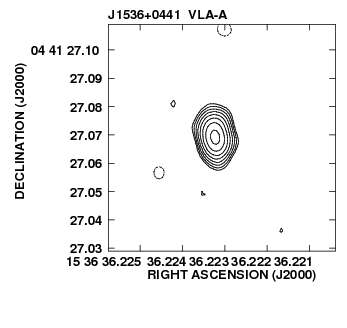
|
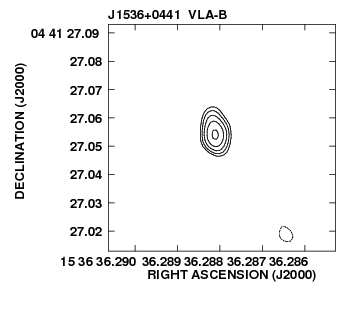
|
|
Fig.2: Contour plots of components VLA-A (right) and VLA-B (left). The beam size is 12 x 7 mas in PA 10 degree. The 1sigma rms noise is about 0.015 mJy/beam and the peak brightness are 0.60 mJy/beam and 0.20 mJy/beam, respectively. |
|
eVLBI helps hunting high energy emission properties in the radio galaxy M87
The radio galaxy M87 (3C274, Virgo A) is one of the nearest Active Galactic
Nuclei (AGN) and hence one of the most interesting for all astronomers. It
is one of the few radio galaxies ever detected at TeV energies and an ideal
target to look in order to constrain the place of high energy emission. In
particular, both the bright compact core at the jet base (left panel in the
image) and the so called HST-1 complex some 800 mas downstream the jet
(right panel) have been proposed as possible candidates for the TeV production
in recent years.
A monitoring of this source with the eEVN has started a few months ago (PI
M. Giroletti), at a frequency of 5 GHz, which offers the best compromise
between sensitivity, angular resolution, and wide field of view. This
monitoring has exploited the frequent observing windows offered by the eVLBI
sessions, and it was carried out during the season in which TeV observations
were possible.
Indeed, on Feb 6th the source has been detected at TeV energies (ATel 2431),
right after one of the epochs of our monitoring had been obtaind. Thanks to
the prompt delivery of results permitted by real time correlation and
pipelining at JIVE, we have immediately checked the status of the radio jet.
No big anomalies have been found in either the core nor HST-1, showing that the
action was yet to come (ATel 2437). A more recent TeV flare has also been
reported (ATel 2542), and it has triggered X-ray observations and a target
of opportunity request to extend the monitoring further.
In addition to studying the connection to the high energy emission, the
observations are allowing us to study the jet structure and kinematics with
great detail. For example, a proper motion of components within HST-1 is
clearly revealed from epoch to epoch, implying superluminal velocities.
Authors:
M. Giroletti (INAF)
|
|
First EVN pulsar gating correlation with the DiFX correlator in Bonn:
detection of the Fermi/GBT pulsar PSR J2032+4127
Pulsars have usually been discovered by performing blind searches at radio
wavelengths.
In some cases, pulsed emission above GeV energies has been detected, either
by the MAGIC
ground-based Cherenkov telescope or by the Fermi satellite. A blind search
for pulsars with
the Fermi satellite led to the discovery of the 143 ms period gamma-ray
pulsar PSR J2032+4127,
which falls in the region of the unidentified very-high-energy source TeV
J2032+4130.
Subsequently the pulsar was also detected in the radio, using the Green Bank
Telescope, with a
period-averaged flux density of 0.12∓0.03 mJy at 2 GHz and 0.65∓0.13
mJy at 0.8 GHz
(Camilo et al. 2009). The dispersion measure was found to be 114.8∓0.1
pc/cm3,
corresponding to a distance of 3.6 kpc according to the Cordes & Lazio
(2002) model.
VLBI observations of radio pulsars can provide accurate proper motions, and
in some cases
parallaxes. In normal VLBI observations of radio pulsars one measures the
period-averaged
flux density along the integration time, although most of the time the
pulsar is not emitting.
The instantaneous flux density during the pulsation is usually tens of times
higher than the
period-averaged value, because the duty cycle (the ratio of the pulse width
to the pulse period)
is usually below 10%. To optimize VLBI observations of pulsars one can take
advantage of this
fact by only correlating the data during on-pulse, and disabling correlation
during off-pulse.
This technique is known as pulsar gating. The total correlated time is
considerably reduced
(a few minutes for every observed hour), increasing the final image noise by
a factor
proportional to one over the square root of the duty cycle. However, the
signal increase is
approximately proportional to one over the duty cycle. This provides a
theoretical signal-to-noise
ratio increase proportional to one over the square root of the duty cycle of
the pulsar.
Typically, the real signal-to-noise improves a factor between 2 and 6, which
can make the
difference between a non-detection and a clear detection, which leads to
accurate astrometry.
More sophisticated correlations can be used, as weighting the signal
according to the pulse shape
(matched filter).
Until now it has not been possible to perform pulsar gating correlation of
EVN data in Europe,
and therefore it was difficult to combine the high sensitivity of this array
with the enhancement
of pulsar gating. Pulsar gating correlations can be naturally set in the new
software DiFX
correlators (Deller et al. 2007), and have been successfully performed in
the VLBA and LBA
correlators. For the EVN, the recently updated DiFX correlator in Bonn can
now be used to
correlate data using pulsar gating. This possibility will also be available
soon at the new
SFXC software EVN correlator at JIVE.
We observed the Fermi/GBT pulsar PSR J2032+4127 with the EVN at 1.6 GHz in
March 2010.
The source has a period-averaged flux density of 0.18 mJy and a duty cycle
of approximately
10% at this frequency. To obtain a good position of the source, we observed
it using phase
referencing with 6 EVN antennas (Ef, Jb, Mc, On, Tr, and Wb) at 1 Gbps, and
we correlated the
data using pulsar gating in the new DiFX correlator in Bonn. The updated
pulsar ephemerides
needed to set the gates were obtained through regular pulsar observations
made with the Lovell
telescope at the Jodrell Bank Observatory. All the technical support
required for correlating
and checking the EVN data was provided by Walter Alef, David Graham, John
Morgan, and Helge
Rottmann (Max-Planck-Institut für Radioastronomie). A preliminary data
reduction shows that
the faint pulsar was detected with a signal-to-noise ratio of 8, with an
improvement of a
factor of 2 thanks to the use of pulsar gating. This has provided the first
accurate VLBI
position of this faint radio pulsar. Future EVN observations will allow us
to obtain an
accurate proper motion of PSR J2032+4127, which will shed light to the
possible association
of this pulsar with the unidentified very-high-energy gamma-ray source TeV
J2032+4130.
Camilo, F., et al. 2009, ApJ, 705, 1
Cordes, J.M., & Lazio, T.J.W., 2002, arXiv:astro-ph/0207156
Deller, A.T., Tingay, S.J., Bailes, M., & West, C. 2007, PASP, 119, 318
Authors:
Moldón, J.(1)Ribó, M.(1), Paredes, J.M.(1), Bosch-Ramon, V.(2),
Kramer, M.(3,4),
Lyne, A.G.(3), Stappers, B.W.(3)
(1) Departament d'Astronomia i Meteorologia and Institut de Ciències del
Cosmos (ICC)
Universitat de Barcelona (IEEC-UB)
(2) Max Planck Institut für Kernphys
(3) Jodrell Bank Centre for Astrophysics
(4) Max Planck Institut für Radioastronom
|
Fig.1: Preliminary images of PSR J2032+4127 obtained with 6 stations of the EVN at 1.6 GHz. The data were correlated with the new DiFX correlator in Bonn using pulsar gating, which improved the signal-to-noise ratio by a factor of 2. The left image corresponds to the data correlated during on-pulse (0.1 phase bin), and the right image during off-pulse (for a 0.1 phase bin as well). |
Aql X-1 in outburst
Aql X-1 is a recurrent transient X-ray binary system comprising a neutron
star and
a main sequence star. The compact object is accreting matter from the
companion via
an accretion disc. It is expected that matter is ejected from the system in
the form
of a relatively narrow outflow called jet.
Aql X-1 exhibits outbursts about once a year, during which the X-ray and
optical
emissions are suddenly increasing and, the paradigm says, blobs of matter
are launched
in the interstellar space at near relativistic speeds forming a powerful
jet. Generally
speaking, the jets can be best observed at radio wavelengths. Unfortunately
they are
usually very faint, close to the sensitivity limits of radio facilities.
Thus the
outbursts offer some of the best opportunities to try to detect them.
In November 2009, Aql X-1 has been very active again. A multi-wavelength
campaign was
set in motion, with observations at radio, optical and X-ray frequencies.
The EVN
observed the system at 5 GHz for about 4.5 h. The resulting radio map is
shown.
Although Aql X-1 has been detected at radio frequencies during previous
outbursts,
this is the first time when high-resolution (mas scale) images of the system
have
been captured. More interestingly, a marginally significant extended
emission component
is apparent towards south-east. This would imply a jet of size 10 mas (50 AU
at 5 kpc).
However, VLBA observations made on the same day at 8.4 GHz were consistent
with an
unresolved source. Simulations showed that a possible explanation for this
is that the
faint extended emission seen by the EVN is resolved out by the VLBA.
Alternatively,
the extension in the EVN image is an artifact.
The full analysis of the EVN, VLBA, VLA and RXTE (Rossi X-ray Timing
Explorer) data
is presented in a paper submitted to ApJ Lett.: "Evolution of the
radio/X-ray coupling
throughout an entire outburst of Aquila X-1" by J.C.A. Miller-Jones, G.R.
Sivakoff,
D. Altamirano, V. Tudose, S. Migliari, V. Dhawan, R.P. Fender, M.A. Garrett,
S. Heinz,
E.G. Koerding, H.A. Krimm, M. Linares, D. Maitra, S. Markoff, Z. Paragi,
R.A. Remillard,
M.P. Rupen, A. Rushton, D.M. Russell, C.L. Sarazin, R.E. Spencer
|
|
4. EVN
Technical Development and Operations
First results with the 3 mm receiver at the 40m telescope (Yebes) - fringes
with Onsala and Metsähovi
Two important results have been achieved at Yebes (Observatorio Astron├│mico
Nacional) the second half of April. Both are related to the new 3 mm
receiver installed at the 40 m radiotelescope. We hope that they are the
first step for future results at this frequency with the 40 m antenna.
The 3 mm receiver was installed at the 40 m telescope by the beginning of
December 2009. The frontend was previously used at Plateu de Bure and
belonged to IRAM. Its receiver temperature is approximately 70 K and its
system temperature 200 K. It has got two linear polarized channels: at 1 and
3 mm. Circular polarization is achieved by inserting a teflon plate in front
of the horn. The plate can easily be rotated 90 degrees. The 3 mm receiver
IF and the control and monitor system were built at Yebes . The receiver
uses a cold/hot load scheme to calibrate in amplitude. Switching between
hot/cold and sky is done in less than 2 seconds by moving mirrors. The cold
load is done by using a mirror which looks into the cryostat.
On April 21st 2010, Yebes 40 m radiotelescope took part for the first time
in a 2 hour fringe test at 86 GHz together with Onsala 20 m and
Metsähovi
14 m telescopes. Data were recorded on the 3 telescopes in disk packs and
later transfered to Bonn correlator. The data were extracted using
fuseMark5, which allows to mount the disk packs as an external disk, and
transferred later using tsunami. Fringes were found in the three baselines
with SNRs from 50 to 110. Metsähovi recorded the data on two polarizations,
while Yebes and Onsala only used one circular polarization. Since
polarization sense was unknown at Yebes, 6 scans were recorded with the
plate in front of the horn in a given position and 2 were recorded after the
plate was rotated 90 degrees.
The week after the sucessful VLBI fringe test, the SiO 2-1 V1 line towards
evolved star IK Tau and R Cas was detected using an autocorrelator of 2048
channels and a bandwidth of 256 MHz. The line was checked with a similar
observation at Pico de Veleta. Figure 1 shows the line.
Our next goal is to improve the efficiency of the antenna by adjusting the
panels of the main reflector and by replacing the current membrane at the
receiver cabin vertex. We expect that the eficciency may increase 4 times
after these works.
We wish to thank you the staff at Onsala, Metsähovi and at the Bonn
Correlator (Dave Graham and Walter Alef) for their help during the fringe
test and their work at the correlator.
Pablo de Vicente (Observatorio Astron├│mico Nacional) Fig.1:
Spectra of the SiO 2-1 V1 line towards IK Tau.
Fig.1:
3 mm receiver at the 40m cabin. The photograph shows the cryostat, mirror
system (with the hot load) and the IF below the supporting structure.
The members of NEXPReS (Novel EXplorations Pushing Robust e-VLBI
Services) have completed contract negotiations and submitted all
materials for final contract approval. The three year, follow-on project
to EXPReS is expected to receive 3.5M EUR from the EC and to begin 1
July.
The main goal of NEXPReS is to remove the current distinction between
disk-based and electronic VLBI, creating a system in which all
observations benefit from having a real-time component, while retaining
the option to re-correlate the data at a later time with more telescopes
and/or different correlation parameters.
Development will be focused in four main Service and Joint Research
Activities:
"Cloud Correlation" will develop high-speed (>1 Gbps)
recording/transmitting capabilities for the full observation cycle,
taking advantage of the higher observing bandwidths available to the EVN
within the next few years and preparing the EVN for the higher
operational data rates that will follow.
"High Bandwidth on Demand" will encourage the adoption of dynamic
networking technologies on a European and global scale, pushing the
capabilities with e-VLBI and LOFAR applications.
"Computing in a Shared Infrastructure" will create an automated,
distributed correlator, developing the components of a real-time
infrastructure that integrates network and computing resources.
"Provisioning High-Bandwidth, High-Capacity Networked Storage on
Demand" has two distinct aims with a common storage component. First, it
will explore ways to implement on-demand, distributed, networked storage
that can match the future multi-Gbps bandwidth and petabyte-class
capacity requirements of VLBI. Second, it will address the use of such
high-capacity storage systems for the data archives of the future, such
as the SKA.
NEXPReS will also continue the Networking Activities supported by
EXPReS, including the EVN-NREN Forum, eVSAG and Outreach activities.
o:p>
NEXPReS is coordinated by JIVE and comprised of:
Joint Institute for VLBI in Europe (JIVE, The Netherlands)
Stichting Astronomisch Onderzoek in Nederland (ASTRON, The
Netherlands)
Istituto Nazionale di Astrofisica (INAF, Italy)
Max Planck Gesellschaft zur Foerderung der Wissenschaften E.V. (MPG,
Germany)
The University of Manchester (UMAN, UK)
Chalmers Tekniska Hoegskola AB (OSO, Sweden)
Ventspils Augstskola (VENT, Latvia)
Fundacion General de la Universidad de Alcala, Instituto Geografico
Nacional (FG-IGN, Spain)
NORDUnet A/S (NorduNet, Denmark)
SURFnet bv (SURFnet, The Netherlands)
Instytut Chemii Bioorganicznej Pan (PSNC, Poland)
Delivery of Advanced Network Technology to Europe Limited (DANTE,UK)
Aalto-yliopisto (formerly Teknillinen Korkeakoulu, Finland)
Technische Universitaet Muenchen (TUM, Germany)
Commonwealth Scientific and Industrial Research Organisation (CSIRO,
Australia)
Kristine Yun (JIVE)
The Square Kilometre Array project is the main global undertaking of the
radio astronomy community for the XXI century. It involves massive
technological developments in all areas of radio astronomy instrumentation.
In particular, the SKA will require new methods of high rate data transport
and processing. The EVN is conducting a development programme called e-EVN
which aims at creating a VLBI network based on modern technologies including
broad-band data transmission and real-time data processing.
In response to the Call issued by the SKA Project in 2009, the EVN
Consortium has submitted a proposal for recognising the e-EVN programme as
an SKA Pathfinder. The programme is being funded by the participating
institutes and, importantly, through external funding sources, such as the
recently successfully completed EC FP6 project EXPReS and the new EC FP7
proposal NEXPReS (see more in the article by K. Yun in this issue of the EVN
Newsletter).
The e-EVN programme corresponds to the SKA development in the following
three areas:
Science: The science case of the e-EVN development is focused at the
centiarcsecond to sub-millarcsecond scale studies of faint radio sources at
the frequency bands from 0.3 to 43 GHz, with a fast response time on targets
of opportunity and near real-time availability of correlator output data for
astronomical analysis. The science case of e-EVN is consistent and
synergistic to several of the major SKA science drivers.
Technology:
The key element of the e-EVN programme is an introduction of the e-VLBI
technique which enables real-time data transfer from remote radio telescopes
to the central processing facility via optical fibre cables - as opposed to
the "traditional" implementations of VLBI in which the data are first
recorded at the telescopes on magnetic media (tapes or discs) and then
physically delivered to the processor. Over the last four years, the fibre
cable network link has been established to most of the EVN telescopes and,
in some cases, to non-EVN VLBI stations at trans- and intercontinental
distances. The data rate achieved so far reaches 1 Gbps per VLBI station.
This value will increase in the next few years to 4 Gbps per station and to
16 Gbps/station in a 5-7 year perspective. Further developments will include
data caching mechanisms aiming to increase the robustness of operations of
distributed facilities, such as EVN and SKA, for both "raw" and "user" data streams.
Operations:
Since the introduction of e-VLBI in the arsenal of operational modes of the
EVN, the network as a whole and its institutes are developing operational
practices that are required for scientifically efficient use of the
large-scale real-time astronomical facility. The EVN has offered access to
e-VLBI observations to the world-wide user community since 2006. The
experience of the EVN e-VLBI operations is directly applicable to the SKA as
an open large scale facility with real time transmission and processing of
large amounts of data.
Leonid Gurvits (JIVE)
Keeping in step with the rest of the world of VLBI, Arecibo is
upgrading its VLBI instrumentation. Recent developments in digital data
acquisition systems and disk recorders will allow Arecibo to
record 1-GHz total bandwidth within its RF-frequency range of 1
- 10 GHz. This will employ a RDBE purchased from NRAO and a Mark5C
recorder from Conduant Corp. The Mark5C recorder is already at Arecibo,
with the necessary software under development at Haystack Observatory.
We hope to bring the new system into service when the RDBE is delivered
later this year.
In addition, a Patriot 12-m antenna is under construction on the hill
directly overlooking the Arecibo Observatory gatehouse. From there,
the fully steerable 12-m dish will have a clear view of almost the
whole "sky" down to an elevation of 5 degrees. The telescope surface is
capable of supporting operations to well above the 10-GHz limit of the
305-m dish. However, for the foreseeable future it is planned to
operate between 1 and 12 GHz. Initially, the dish will be equipped
with a dual-frequency S/X feed purchased from Patriot, and a receiver
system produced in-house. However, it is planned that a wide-band
receiver system will later replace this, leaning on community design
efforts for the VLBI2010 geodesy project, and the SKA and its
precursors.
The prime motive for investing considerable effort into this small
telescope lies in the area of phase-referenced VLBI for astronomical
imaging. The low slew rate of the 305-m telescope has meant that some
of the potential sensitivity provided to VLBI imaging by the giant dish
has been lost due to the time taken to slew between target and
reference sources. In future, the small dish will track the (strong)
reference source, so its "big brother" need only observe this
occasionally. The phase derived from 12-m baselines with other
telescopes will then be "copied over" to phase-correct the 305-m
fringes to those same telescopes. A second RBDE and Mark5C pair will
form the VLBI backend for this antenna.
In addition to its usage as a 'Reference antenna" for the 305-m, the
12-m antenna itself could serve as a "stand-alone element" in any VLBI
array. We note that the baseline to the St. Croix VLBA antenna would
provide useful short spacing information, thereby improving both
calibration and overall image quality. Further, the design of the
fast-slewing Patriot dish makes it highly attractive for geodetic VLBI
observations under the "umbrella" of VLBI2010. It will also be
possible to route the signal from the small telescope to Arecibo's
existing spectrometers, opening up possibilities for its use as a
stand-alone telescope for either teaching or single-dish research.
Tapasi Ghosh & Chris Salter
JIVE: It was agreed that the Mark4 DAS and associated spare parts,
which are no longer used at the
WSRT, will be given to the Kunming station in China.
A status update on the Hartebeesthoek 26m antenna repair:
The foundations of the temporary A-frame support structure have been cast
and the necessary steel work is currently being fabricated, with on-site
erection beginning in early June. If all goes according to plan we would
hope to return to normal operations some time in August.
2010 Session 1: 4 March - 25 March Wavelengths: 18, 5, 6, 13/3.6 cm
This was again a full session lasting 21 days. Arecibo was scheduled
for 4 observations but due to telescope structural failure could not
take part. Robledo was scheduled for 6h for 1 observation. GBT was
scheduled for 4 observations. VLBA was scheduled for 6 observations.
The VLBA correlator was used for 3 observations, the Bonn (software)
correlator for 2, and the EVN correlator at JIVE for the others. A
UHF-band project planned for this session proved not to be technically
feasible at Arecibo and was thus withdrawn.
A total of 19 proposals (including 1 ToO) were scheduled, comprising
27 observations as follows: 18cm (10), 5cm (7), 6cm (8), 3.6cm (1),
3.6/13cm (1). The KVAZAR network telescopes Zc and Bd took part for
the first time as full EVN members in the network monitoring runs at
18, 6 and 3.6/13 cm. The Shanghai telescope took part for the first
time at 5cm.
SESSION STATISTICS SINCE MAY 2002
EVNrecorded projected 1Gbps N-OBS HOURS DAYS T-BYTES TB/TEL N-TEL T-bytes Tb/tel recorded/projected may02 17 200.5 8.4 142.9 16.8 8.5 633.2 74.9 0.23 nov02 19 211.5 8.8 108.0 16.2 6.6 301.3 40.4 0.36 feb03 6 58.5 2.4 27.7 4.8 5.5 40.8 7.7 0.68 may03 31 338.5 14.1 196.0 24.9 7.7 444.1 51.6 0.44 oct03 22 233.5 9.7 187.1 23.1 8.0 673.7 76.0 0.28 feb04 21 160.5 6.7 131.7 16.3 8.0 326.7 39.3 0.40 may04 23 251.7 10.5 153.8 19.3 7.7 351.6 40.9 0.44 oct04 33 364.5 15.2 195.5 29.3 6.2 410.0 51.7 0.48 feb05 19 266.8 11.1 205.5 31.2 8.2 535.5 66.9 0.38 jun05 19 204.7 8.5 210.5 29.7 9.2 613.9 67.9 0.34 oct05 26 225.3 9.4 277.7 35.7 7.3 476.5 56.9 0.58 feb06 24 220.7 9.2 159.9 20.1 8.3 297.0 34.0 0.54 jun06 24 228.5 9.5 337.5 37.4 8.0 546.4 61.4 0.62 nov06 9 74.0 3.1 117.5 13.8 6.1 214.4 24.9 0.55 feb07 32 222.5 9.3 378.2 40.6 9.1 807.4 89.2 0.47 jun07 25 251.5 10.5 294.8 44.1 8.6 471.4 64.5 0.63 oct07 13 176.0 7.3 265.5 43.1 6.6 319.1 50.2 0.83 feb08 29 298.5 12.4 458.2 52.9 8.6 701.0 80.4 0.65 jun08 29 250.7 10.4 419.0 42.7 9.6 620.4 65.4 0.68 oct08 21 207.0 8.6 391.4 45.7 8.3 680.5 78.0 0.58 feb09 28.0 222.0 9.3 428.0 48.5 8.5 521.5 59.5 0.82 jun09 29 243.0 10.1 555.9 59.2 9.2 700.7 76.0 0.79 oct09 30 331.0 13.8 548.1 69.1 8.4 802.2 95.6 0.68 mar10 33 302.3 12.6 631.7 80.7 8.3 693.1 87.7 0.91
"projected 1Gbps(T-bytes Tb/tel)" indicates the quantity of data that would
have been recorded if all suitable projects had been recorded at 1 Gbps.
e-VLBI SCHEDULING SINCE THE LAST EVN NEWSLETTER Date λ Duration 10FEB10 6cm 18h 2 normal
+ 2 ToO + 1 trigger proposal (not triggered)
30MAR10 6cm 19h 2 normal + 1
s.obs + 1 ToO + 1 trigger proposal (not triggered) 22APR10 18cm 18h 1 normal + 1 ToO 18MAY10 6cm 12h 1 s.obs + 1 ToO + 1 trigger proposal (on standby)
UPS AND DOWNS OF TELESCOPES
follows:
Eb: Azimuth track cracked December 21; fixed January 2010.
Hh: "Estimated repair completion dates have moved out to August"
Ar: Feb 8: "major structural problem detected on the hanging
platform, that has compromised the telescope tracking capability"
Mar 24: "Arecibo telescope has now been partially released
to operate within the ZA range of 6 - 10 degs.
Zc,Bd:
Mar 4: "Ftp data arrived for Ef, Nt, On, Wb, Mc, Tr, Jb, Cm, Kn, Sh, Zc,
Bd. There were fringes to all stations but Cm. Please note here
that
the QUASAR Russian stations Bd and Zc participated for the first
time in the EVN fringe tests"
Sv:
Apr 7: "can't tell you exactly if Svetloe will be ready or not
for 2nd EVN Session."
Nt:
Apr 6: "the Noto 32m radio telescope has experienced about a week
ago a major failure of a bearing in one engine of the azimuth wheel"
"participation of Noto to the May/June session seems difficult at
present, since in any case the repair is likely long."
Sh:
Mar 5: "This is to let you know that we have successfully installed the
6.7 GHz receiver at Sheshan 25m telescope. Then some single-dish
testing observations of methanol lines showed that the
system works,
although some calibration work is still needed. As such, we think
that we can join the 5cm EVN observations in this March session
(at least) in its testing mode."
Sh,Ur:
Not available for Session III due to requirement for tracking new
Chinese Lunar spacecraft.
DATES FOR SESSIONS Session Date 2010 Session 1 Mar 4 - Mar 25 2010 Session 2 May 27 - Jun 17 2010 Session 3 Oct 21 - Nov 11
EVN sessions in 2011 (recently agreed)
Session Date 2011 Session 1 Feb 24 - Mar 17 2011 Session 2 May 26 - Jun 16 2011 Session 3 Oct 20 - Nov 10
Richard Porcas (EVN Scheduler)
European e-VLBI at very low frequencies has recently produced the
first maps with a resolution of 1-2 arcsec.
The low-frequency array LOFAR currently consists of about two dozen
stations in the Netherlands plus four in Germany. Of the latter, the
ones in Effelsberg (near Bonn), Tautenburg (near Jena) and
Unterweilenbach (near Munich) are already connected to the network and
can be correlated with the others. Calibrating and imaging these long
baselines is difficult because of significant clock offsets,
ionospheric delays and differential Faraday rotation.
In an observation of 3C196 in the low-band range (30-80 MHz) with five
Dutch and three German stations, we now used fringe-fitting results to
correct for the clock offsets. After simple automatic flagging and
conversion from linear to circular polarisations (to avoid problems
with differential Faraday rotation), the data were averaged in time and
frequency to write out uvfits files that were then calibrated and
imaged with AIPS and DIFMAP. In this process we defined the 195 kHz
subbands as "IFs" which were self-calibrated independently but using a
common model.
The maps shown in Fig. 1 and 2 were produced with DIFMAP by fitting a
number of Gaussian components with variable spectral index to the
visibilities. Phases were self-calibrated on intervals of 9 sec, while
only one global amplitude solution was allowed for each antenna. The
structure of 3C196 is quite different from the almost symmetric double
seen at high frequencies, but surprisingly consistent with 408 MHz
MTRLI observations (see Fig. 2). As shown in Fig. 1, the long
baselines are essential to show any structure of this source.
The results confirm that LOFAR is able to produce high-resolution images
even with a limited number of stations. The structures shown here rely
on only six independent baselines. The huge fractional bandwidth helps
to fill the uv plane.
Additional stations are currently or soon constructed in Nancay
(France), Chilbolton (England), Onsala (Sweden) and Juelich
(Germany). The station in Potsdam (Germany) is still waiting for its
network connection. With the high-band system, true subarcsec resolution
observations will be possible routinely.
Olaf Wucknitz (AIfA Bonn)
Fig.1:
Maps of 3C196 from a 6h-LOFAR observation covering 30 MHz bandwidth
between 30 and 80 MHz. The total flux of the source at these
frequencies is about 140 Jy. Left: Using only five stations in the
Netherlands. The resolution of 35x22 arcsec is not sufficient
to resolve any details. Right: With the inclusion of long baselines,
and approximately uniform weighting, the resolution is about
1.5x0.9, enough to resolve the four dominating components and
even some structures within them. The colours are close to natural
when red/green/blue are assigned to three bands between 30 and 80 MHz.
Fig.2:
Overlay of the long-baseline LOFAR map (restored with a circular beam
of 1.5 arcsec and slightly exaggerated colours) with contours from
earlier 408 MHz observations with the MTRLI (taken with permission
from Lonsdale & Morison, 1980). Obviously the general structures seen
by LOFAR and MTRLI are consistent with each other, even though the
relative flux densities of the components differ significantly.
EVN Newsletter No. 26.
2010 European VLBI Network. Edited by Magdalena Kunert-Bajraszewska (TCfA, Poland).
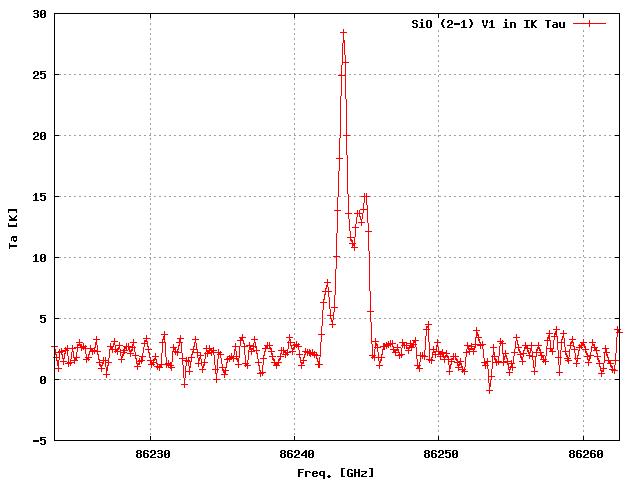
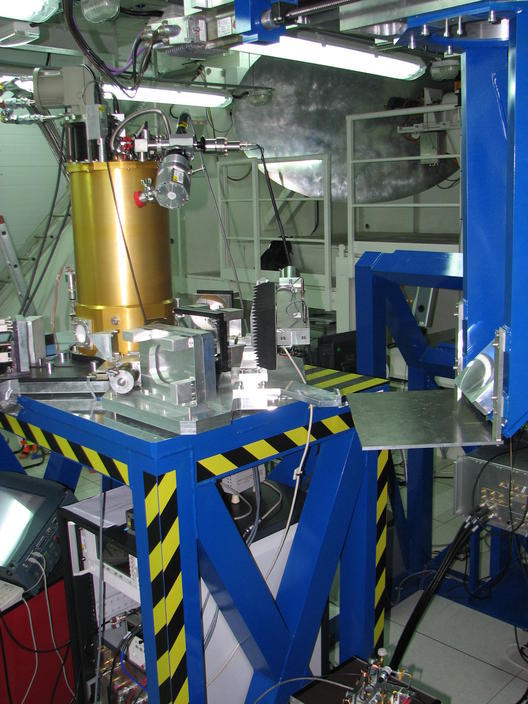
NEXPReS expected to launch 1 July
e-EVN is an SKA Pathfinder
In parallel to establishing the network connectivity to EVN stations, the
e-EVN programme includes relevant hardware and software upgrades of the EVN
Data Processor at JIVE enabling this facility to correlate e-VLBI streams in
real time. The Next Generation FPGA-based EVN Correlator currently being
designed at JIVE will have real-time capability for the incoming data rates
mentioned above as its main specification requirement. This effort is
supplemented by the development of software VLBI correlators at several EVN
institutes using clusters of powerful processors and distributed computing
technologies.
EVN institutes are also involved in the ongoing effort to develop VLBI user
software capable, in particular, of handling large volumes of VLBI
correlator output data in the most efficient way. This effort is being
supported through the EC FP6 and FP7 RadioNet Joint Research Activities
ALBUS and ALBiUS.
All EVN institutes and most of its scientific and engineering personnel are
involved in various SKA-related scientific, technological and other
preparatory activities through a variety of links: direct contacts with the
SKA Pproject Development Office, involvement in various EC funded projects
(SKADS, PrepSKA), national and international SKA-related science and
engineering projects (such as AAVP) and other means. These links will ensure
a proper transfer of the expertise between the e-EVN programme to SKA
Project.
Recently the EVN CBD has been informed by the SKA Science and Engineering
Committee (SSEC) that the status of a recognised SKA Pathfinder had been
granted to the e-EVN programme. This is an important development which makes
the SKA Project even closer to the daily life of the EVN community.
Arecibo's VLBI Upgrade: Wider Bandwidth and a New 12m Antenna
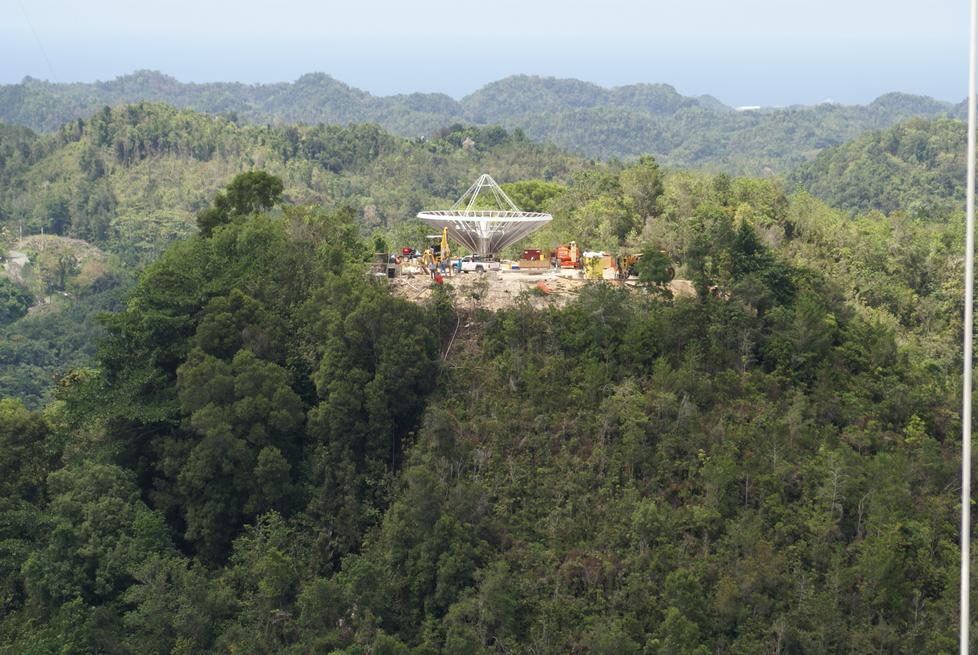
News from EVN stations
EVN Scheduler's Report
Advertized e-VLBI runs were scheduled as follows:
EVN sessions in 2010:
5.
VLBI related news
First long-baseline images from LOFAR
on behalf of
the German Long-Wavelength consortium GLOW and the long
baselines working group. LOFAR is a project of ASTRON (Dwingeloo). The
three contributing German stations are operated by the
"Max-Planck-Institut fuer Radioastronomie" (Effelsberg), the
"Thueringer Landessternwarte" (Tautenburg) and the
"Max-Planck-Institut fuer Astrophysik" (Unterweilenbach).
Efforts of many colleagues at the stations and at ASTRON were required
to make this result possible. We particularly mention James Anderson
(MPIfR), Annette Haas, Matthias Hoeft and Jochen Eisloeffel (TLS),
Benedetta Ciardi (MPA), and George Heald and Antonis Polatidis
(ASTRON).
